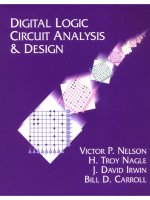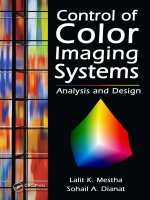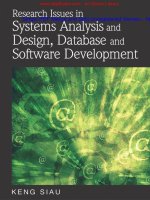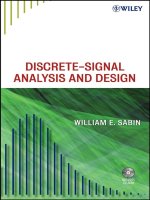DISCRETE-SIGNAL ANALYSIS AND DESIGN- P14 pps
Bạn đang xem bản rút gọn của tài liệu. Xem và tải ngay bản đầy đủ của tài liệu tại đây (165.01 KB, 5 trang )
SPECTRAL LEAKAGE AND ALIASING 51
regions may not be well known, it is usually difÞcult to predict the exact
behavior in the alias region. We will look at ways to deal with these over-
laps so that aliasing is reduced, if not to zero, then at least to sufÞciently
low levels that it becomes unimportant. In many cases a small amount of
aliasing can be tolerated.
We emphasize that Fig. 3-3 deals with phasors. Mathematically, phys-
ical sine and cosine waves as deÞned explicitly in Eq. (2-1) do not exist
as separate entities at negative frequencies, despite occasional rumors to
the contrary. (Instruments such as spectrum analyzers, oscilloscopes, etc.
can be used to create certain visual illusions; the Wells-Fargo stage coach
wheels in old-time Westerns often appear to be turning in the wrong direc-
tion.) For example, as compared to phasors that can rotate at positive or
negative angular frequencies,
cos(−ωt) = cos(+ωt) (3-3)
sin(−ωt) =−sin(+ωt) = sin(+ωt)∠ ± 180
◦
(3-4)
We note also that the average power in any single phasor of any constant
amplitude is zero ± the resolution of the computer. So the phasor at
frequency (k) must never be thought of as a true signal that can light a
light bulb or communicate.
The sine or cosine wave requires two phasors, one at positive frequency
and one at negative frequency, and the result is at positive frequency. As
an electrical signal the individual phasor is a mathematical concept only
and not a physical entity (we often lose sight of this). Therefore, aliasing
for sine and cosine spectra requires special attention, which we consider
in this chapter.
Adjacent segments of the eternal steady-state positive-frequency sine–
cosine spectrum can overlap at frequencies greater than zero, and it is a
common problem. In Fig. 3-4a the positive- frequency eternal steady-state
spectrum is centered at 5, 15, 25, 35, 45, and so on. Each side of each spec-
trum segment collides with an adjacent segment, producing alias regions.
This spectrum pattern repeats every 10 frequency units. The plots are
shown in Fig. 3-1 as continuous lines rather than discrete lines. We do
this often for convenience, with the understanding that a discrete spectrum
is what is intended.
52 DISCRETE-SIGNAL ANALYSIS AND DESIGN
−60 dB
−60 dB
−60 dB(c)
(b)
(a)
0
5
15
25
35
45
Figure 3-4 Removing overlaps (a) in adjacent spectra. (b) The separa-
tions of the BPF center frequencies are increased. (c) The BPF transition
regions are made steeper. The 3-dB bandwidth is held constant.
Any one of these frequency patterns, for example, at 45, can be demod-
ulated (mixed or converted) to baseband, and the original message, 0 to
approximately 10, is recovered completely (if it is sampled adequately),
along with any aliasing “baggage” that exists. The plot in Fig. 3-4b
is similar to what the uncorrupted baseband spectrum might look like
originally.
The baseline for Fig. 3-4 is 60 dB below the peak value. This choice
represents good but not state-of-the-art performance in most communica-
tions equipment design. The desired RF band and the baseband can both
be ampliÞed. In communications equipment design this is a very common
practice that produces the optimum gain and noise Þgure distribution in
the signal path. In this regard, digital signal processors (DSP) require
careful attention to signal and noise levels. The least few signiÞcant bits
need to be functioning for weak signals or noise (noise dithered) and the
maximum levels must not be exceeded too often.
The frequency conversion can also be, and very often is, upward from
baseband to 45, etc. in a transmitter, and gain distribution is important
there also.
SPECTRAL LEAKAGE AND ALIASING 53
The level of aliasing that is permitted is an important speciÞcation. For
many typical radio systems this number can be between 30 dB (medium
performance) and 60 dB (high performance), as shown in Fig. 3-4b and
3-4c. One satisfactory approach is shown in Fig. 3-4b, where the passband
center frequencies are increased sufÞciently. In some systems this method
may have some economic or technical problems; it can sometimes be dif-
Þcult and/or expensive to increase the 5 frequency (Fig. 3-4b) sufÞciently.
Improving the bandpass Þltering of the signal before or after modulation
(transmitter) or before or after demodulation (receiver) using improved
Þlters with a constant value of passband width is very common and very
desirable. This excellent approach is illustrated in Fig. 3-4c, where the
60 dB-bandwidth is reduced by appropriate Þlter design improvements.
The distance at −60 dB between the frequency segments is a “guard
band”, which makes it easier to isolate any segment using a practical
bandpass Þlter.
The plots of Fig. 3-4 can also be a set of independent signals whose
spectra overlap. This is a very important design consideration. The result
is not aliasing, but adjacent channel crosstalk (interference). The methods
of reducing this interference are the same as those that we use to reduce
aliasing.
We often (usually) prefer to think in terms of positive-frequency sine–
cosine waves as described in Chapter 2. This gives us an additional “clas-
sical” insight into aliasing. The situation is shown in Fig. 3-5a, where a
spectrum centered at 600 kHz is translated to baseband by a local oscil-
lator (L.O.). Because the lower frequencies of the signal spectrum appear
to be less than zero, the output signal “bounces” off the zero-frequency
axis and reßects upward in frequency. That is, the output frequency of
a down-converting mixer is the magnitude of the difference between the
input L.O. and the RF. Also implied are a coupling dc block and an
internal short circuit to ground at zero frequency. Figure 3-5b shows the
output of the mixer, including a zero-frequency notch, for each side of the
input spectrum. The alias segment is moved to a high- frequency where
it can interfere, perhaps nonlinearly, with the high-frequency region of
the other part of the output. Additional improvement in the Þlter design
at low frequencies is often needed to reduce this aliasing problem sufÞ-
ciently. In Fig. 3-5b the two components of the output cannot be combined
54 DISCRETE-SIGNAL ANALYSIS AND DESIGN
mathematically unless the nature of the signal and the phase properties of
the Þlter over the entire frequency range are well known.
This example reminds us that some problems are better approached
in the frequency domain. A time-domain analysis of a typical bandpass
−40
−30
−20
−10
0
dB
600
(a)
(b)
1200
kHz
600 kHz
L.O.Freq
12000 600
kHz
−50
−40
−30
−20
−10
0
dB
Negative
Freq
Alias
region
Alias
region
Figure 3-5 After conversion to baseband, the effect of aliasing is visible
after being moved to a high frequency.
SPECTRAL LEAKAGE AND ALIASING 55
Þlter would answer some important questions. Imagine an input sig-
nal whose frequency changes too quickly as it traverses the frequency
range of the Þlter, producing a spectrum distortion that is often seen in a
spectrum analyzer. Time-domain analysis, followed by time-to-frequency
conversion, might not inform us as easily regarding steady-state frequency
aliasing.
An important task is to Þnd the power that resides in the overlap
(aliasing) region. We can do this by integrating the signal that resides
in this region, whose spectral content is known (or estimated). The design
goal is to assure that the power, usually the peak envelope power (PEP)
that leaks into the alias (adjacent channel) region is an acceptable num-
ber of dB below the PEP that resides in the “desired” region. For radio
communications equipment, 60 dB (commercial) or 50 dB (amateur) are
readily achievable and quite satisfactory numbers. Some degradations of
these numbers in transmitters and receivers are due to imperfections
in circuit or system design: for example in a transmitter Þnal ampli-
Þer and in a receiver RF “front- end”. Example 3-2 illustrates this
problem.
Example 3-2: Analysis of Frequency-Domain Aliasing
Figure 3-6 is a simpliÞed example of (a) aliasing between two channels of
a repetitive bandpass Þlter for a repetitive signal spectrum or (b) adjacent
channel interference between two independent adjacent channel signals.
The input signal for this example is Gaussian white noise with a spec-
tral density of 0 dBm (1.0 mW) in a 1.0-Hz band, which is 10.0 W in
the 10-kHz passband. The scanning instrument has a noise bandwidth of
300 Hz, so the passband noise power in that bandwidth is
watts in 300 Hz = 10.0
300
10,000
= 0.3W= 24.77 dBm
where dBm = 10 log
0.3
0.001
(3-5)
The Þlter response is rectangular down to the −40 , dBm (in a 1-Hz
bandwidth) level and then slopes according to the dB-scale straight line









